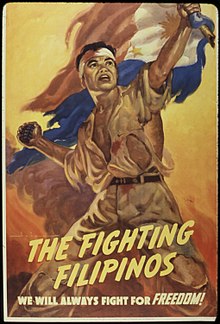
Back مقاومة الفلبين ضد اليابان Arabic Филипинска съпротива Bulgarian Résistance philippine à l'occupation japonaise French Perlawanan Filipina terhadap Jepang ID Resistenza filippina Italian
| Philippine resistance against Japan Paglaban ng Pilipinas sa mga Hapon | |||||||||
|---|---|---|---|---|---|---|---|---|---|
| Part of the Pacific Theater of World War II | |||||||||
 Propaganda poster depicting the Philippine resistance movement | |||||||||
| |||||||||
| Belligerents | |||||||||
|
Moro people[b] | ||||||||
| Commanders and leaders | |||||||||
| Units involved | |||||||||
|
Moro-Bolo Battalion Maranao Militia and others... | ||||||||
| Strength | |||||||||
|
Unknown Japanese 30,000 Constabulary[4] 6,000 Makapili[5] |
30,000 guerrillas in ten sectors (spring 1944)[6] ~260,000 formally recognized members of the pro-US resistance following the war[7] ~30,000 Hukbalahap fighters[7] ~30,000 Moro Juramentados[7] | ||||||||
| Casualties and losses | |||||||||
| 8,000–10,000 dead (before the Allied invasion in October 1944)[7][8] |
8,000 dead (1942-1945)[9] | ||||||||
| Around 530,000[10] to 1,000,000[9][11] Filipinos died during the Japanese occupation. | |||||||||
During the Japanese occupation of the islands in World War II, there was an extensive Philippine resistance movement (Filipino: Kilusan ng Paglaban sa Pilipinas), which opposed the Japanese and their collaborators with active underground and guerrilla activity that increased over the years. Fighting the guerrillas – apart from the Japanese regular forces – were a Japanese-formed Bureau of Constabulary (later taking the name of the old Philippine Constabulary during the Second Republic),[12][13] the Kenpeitai (the Japanese military police),[12] and the Makapili (Filipinos fighting for the Japanese).[14] Postwar studies estimate that around 260,000 people were organized under guerrilla groups and that members of anti-Japanese underground organizations were more numerous.[15][16] Such was their effectiveness that by the end of World War II, Japan controlled only twelve of the forty-eight provinces.
Select units of the resistance would go on to be reorganized and equipped as units of the Philippine Army and Constabulary.[17] The United States Government officially granted payments and benefits to various ethnicities who have fought with the Allies by the war's end. However, only the Filipinos were excluded from such benefits, and since then these veterans have made efforts in finally being acknowledged by the United States. Some 277 separate guerrilla units made up of 260,715 individuals were officially recognized as having fought in the resistance movement.[18]
- ^ Cite error: The named reference
Sinclair2011was invoked but never defined (see the help page). - ^ Cite error: The named reference
Nypaver2017was invoked but never defined (see the help page). - ^ a b Tan, Chee-Beng (2012). Routledge Handbook of the Chinese Diaspora. Routledge. pp. 335–336.
- ^ Hunt, Ray C.; Bernard Norling (2000). Behind Japanese Lines: An American Guerrilla in the Philippines. University Press of Kentucky. p. 107. ISBN 978-0-8131-0986-2. Retrieved February 24, 2011.
- ^ Stein Ugelvik Larsen, Fascism Outside Europe, Columbia University Press, 2001, p. 785
- ^ MacArthur, Douglas (1966). Reports of General MacArthur: Japanese Operations in the Southwest Pacific Area Volume 2, Part 1. JAPANESE DEMOBILIZATION BUREAUX RECORDS. p. 311. Retrieved January 25, 2020.
- ^ a b c d Gordon L. Rottman (2002). World War 2 Pacific Island Guide. Greenwood Publishing Group. pp. 287–289. ISBN 978-0-313-31395-0.
- ^ Clodfelter, Micheal (2002). Warfare and Armed Conflicts: A Statistical Reference to Casualty and Other Figures, 1500–2000. McFarland & Company. p. 566. ISBN 9780786412044.
- ^ a b Clodfelter, Micheal (May 9, 2017). Warfare and Armed Conflicts: A Statistical Encyclopedia of Casualty and Other Figures, 1492-2015, 4th ed. McFarland. p. 512. ISBN 978-0-7864-7470-7.
- ^ Werner Gruhl, Imperial Japan's World War Two, 1931–1945 Transaction 2007 ISBN 978-0-7658-0352-8 p. 143-144
- ^ Anne Sharp Wells (September 28, 2009). The A to Z of World War II: The War Against Japan. Scarecrow Press. p. 16. ISBN 978-0-8108-7026-0.
"Research Starters: Worldwide Deaths in World War II". New Orleans, United States: The National WWII Museum. Retrieved July 23, 2019.
"AJR-27 War crimes: Japanese military during World War II". California Legislative Information. State of California. August 26, 1999. Retrieved July 23, 2019.WHEREAS, At the February 1945 "Battle of Manila," 100,000 men, women, and children were killed by Japanese armed forces in inhumane ways, adding to a total death toll that may have exceeded one million Filipinos during the Japanese occupation of the Philippines, which began in December 1941 and ended in August 1945;
- ^ a b "The Guerrilla War". American Experience. PBS. Retrieved February 24, 2011.
- ^ Jubair, Salah. "The Japanese Invasion". Maranao.Com. Archived from the original on July 27, 2010. Retrieved February 23, 2011.
- ^ "Have a bolo will travel". Asian Journal. Archived from the original on July 7, 2011. Retrieved February 24, 2011.
- ^ "People & Events: Filipinos and the War". PBS.org. WGBH. 1999. Archived from the original on August 23, 2020. Retrieved September 2, 2014.
Rottman, Gordon (August 20, 2013). US Special Warfare Units in the Pacific Theater 1941–45. Osprey Publishing. p. 43. ISBN 978-1472805249. Retrieved September 2, 2014. - ^ Lapham, Robert; Norling, Bernard (1996). Lapham's Raiders: Guerrillas in the Philippines, 1942–1945. University Press of Kentucky. p. 225. ISBN 978-0813126661. Retrieved September 2, 2014.
- ^ Rottman, Godron L. (2002). World War 2 Pacific island guide. Westport, Connecticut: Greenwood Publishing Group. p. 318. ISBN 978-0-313-31395-0. Retrieved May 7, 2011.
- ^ Schmidt, Larry S. (1982). American Involvement in the Filipino Resistance Movement on Mindanao During the Japanese Occupation, 1942–1945 (PDF) (Master of Military Art and Science thesis). U.S. Army Command and General Staff College. p. 2. Archived (PDF) from the original on November 11, 2011. Retrieved August 5, 2011.
Cite error: There are <ref group=lower-alpha> tags or {{efn}} templates on this page, but the references will not show without a {{reflist|group=lower-alpha}} template or {{notelist}} template (see the help page).
© MMXXIII Rich X Search. We shall prevail. All rights reserved. Rich X Search